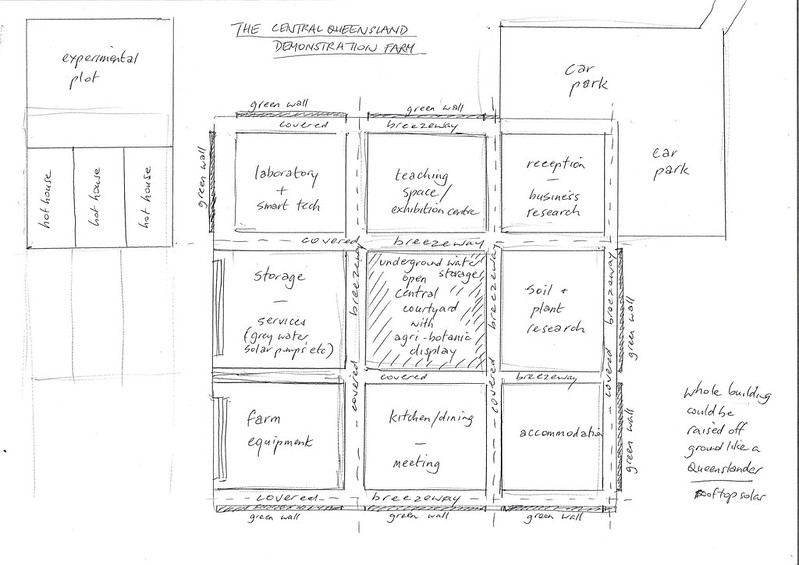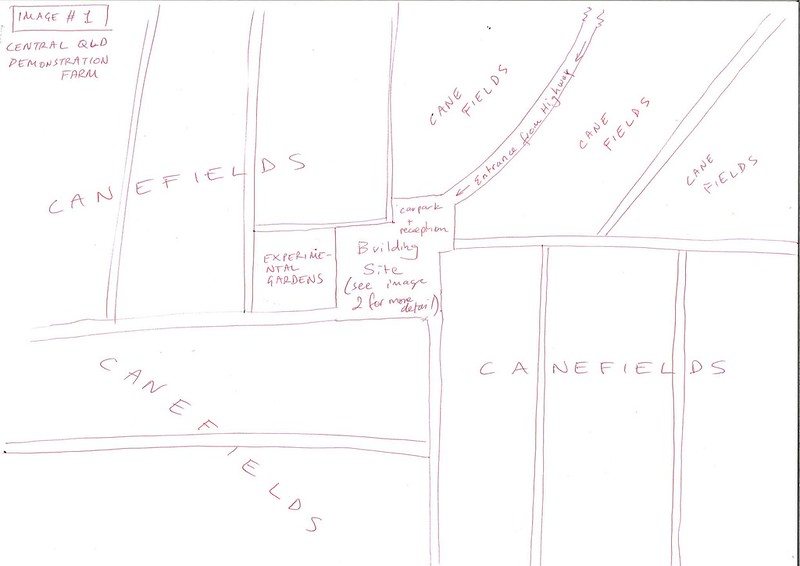Central Queensland Demonstration Farm Sketch
The idea, cooked up with Simon Mattsson and John Sweet, for a demonstration farm for the sugarcane industry has been kicking around for a few years now. This week Kim and I reconvened to think about pushing it a bit further. We’re working with an architect to sketch up a visualisation of the facility. The thinking is that having something to look at will help make the whole thing seem more real (rather than just an idea). Which will make it all the more likely to get funding from the federal or state government.
These are a few drawings we sent to our friend Shaz the Architect. We’re hoping she’ll make it much more official looking and maybe even add a few curves to this otherwise very schematic and rectilinear design.
The Goals of a demonstration farm would be to:
- Support the economic viability of the sugarcane industry through innovation in regenerative soil techniques;
- Improve the health of the Great Barrier Reef Reduce by reducing farm runoff through the use of regenerative agriculture and building soil carbon;
- Encourage farmers to adopt practices of soil improvement (thereby reducing the need for chemical fertilisers and pesticides);
- Educate the farming community and the wider public about these innovations through tangible examples of regenerative agriculture at work;
- Create a framework for collaborating on big picture agriculture industry problems such as the relationship between production, milling, and global distribution.
- Build community through grassroots engagement in agricultural and ecological research and teaching.
What would it consist of:
- Laboratories capable of performing a wide range of research, including testing of the chemical, structural and biological make up of soil, insects, biology and plants;
- Teaching and research facilities attached to the laboratories, so that information collected can be shared with a wide range of people from school children, to farmers, to other research organisations including international visitors;
- Specialised farm equipment necessary for the planting, growing, harvesting, cleaning, processing and storage of a wide range of plants and animals;
- Joint ownership of the land currently owned by Simon Mattsson and some additional land to facilitate the broad range of activities necessary for a Regenerative Agriculture demonstration farm while at the same time enabling the economies of scale necessary to enable a self-sustaining commercial sugarcane enterprise to coexist. This extra scale will also justify the investment in the above mentioned equipment;
- Accommodation and catering facilities so that scientists, lab technicians and visitors can stay on site during research activities;
- Cultural Facilities for celebrations, performances and events;
- Agri-tourism Facilities to show how farming can tap into diverse economies and involve public outreach
Steps towards the Demonstration Farm:
- Discuss idea and scope
- Assemble working group and confirm institutional partnerships
- Raise initial seed funding to research and develop proposal and consult community
- Develop full proposal
- Seek Funding
- Begin Implementation
- BUDGET indications
- Practical steps and a timeline
Potential Partners:
- Central Queensland University
- GBRMPA Mackay
- Pioneer Catchment and Landcare
- Reef Catchments Mackay
- Greater Whitsunday Food Network (Deb McLucas, president)
- MADASSIA
- Yuwibara Aboriginal Corporation
- George Christensen MP, Member for Dawson
- Mackay Regional Council
…and many more…
Design principles:
- Carbon positive facility
- Solar panels everywhere (roofs tilted to optimum direction)
- Roofs Collecting water for use of facility (storage under the central agri-botanic gardens)
- Human manure harvesting system
- Green walls
- The demonstration farm is embedded within the larger working farm (ie not set apart in town etc)
- Whole building could be raised to create shaded undercroft (like a queenslander)
References:
Dakota Lakes Research Farm, USA, http://www.dakotalakes.com/
Franklin River Research and Demonstration Farm, Illinois, USA
Kandos School of Cultural Adaptation (KSCA), 2018, “An artist, a farmer and a scientist walk into a bar…”, http://ksca.land/an-artist-a-farmer-and-a-scientist-walk-into-a-bar/
Maloon Institute NSW <http://themullooninstitute.org/vision/
Lucas Ihlein and Kim Williams, 2016, “What Might a Demonstration Farm Look Like?”, Sugar vs the Reef?, https://sugar-vs-the-reef.net/what-might-a-demonstration-farm-look-like/



October 10, 2018 @ 11:39 pm
Update – Shaz the architect has sent through the formalised drawings of the proposed demonstration farm. You can look at them here (PDF file, 2.4mb).
At this stage the form of these buildings is not really the point – it’s more to get the conversations started about what bits a demonstration farm might need.
When we go to actual design stage, we’d make sure we take time to think through the aesthetics and layout thoroughly, taking into account the vernacular architecture of the region, the prevailing climate, the available materials, passive solar, carbon footprint of the building, accessibility, etc etc.